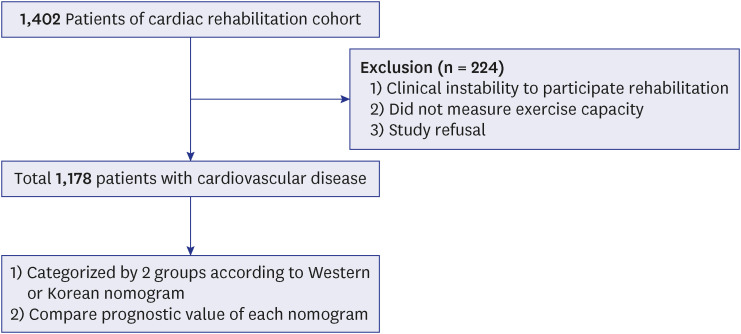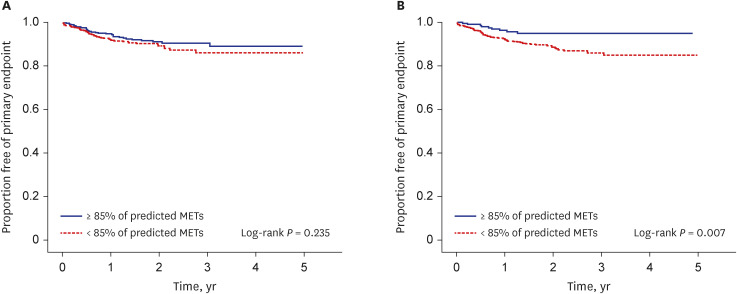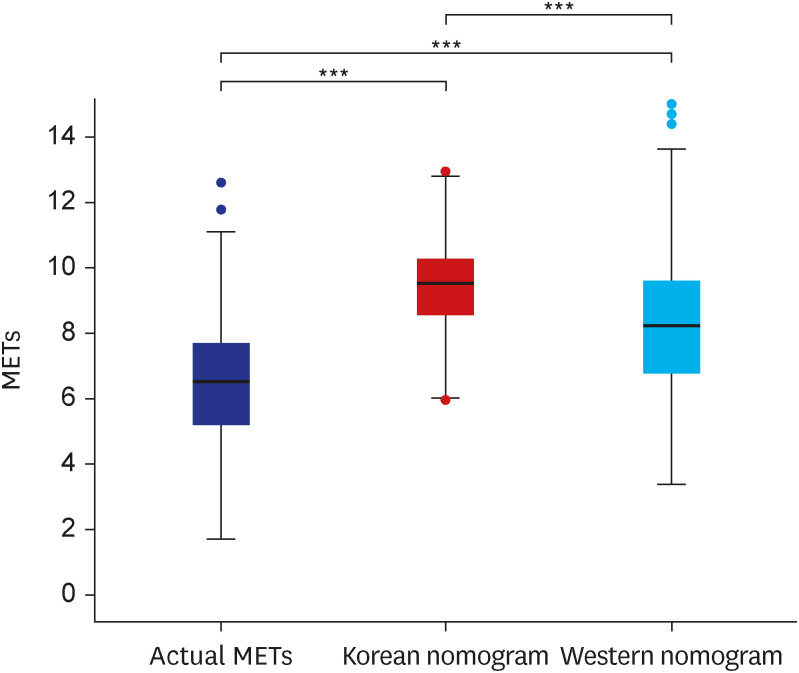J Korean Med Sci.
2023 Jun;38(23):e179. 10.3346/jkms.2023.38.e179.
Korean vs. Western Exercise Capacity Nomograms for Korean Patients With Cardiovascular Disease
- Affiliations
-
- 1Division of Cardiology, Department of Medicine, Korea University Guro Hospital, Seoul, Korea
- 2Department of Rehabilitation Medicine, Korea University Guro Hospital, Seoul, Korea
- 3Sport Medicine Center, Korea University Guro Hospital, Seoul, Korea
- KMID: 2543881
- DOI: http://doi.org/10.3346/jkms.2023.38.e179
Abstract
- Background
Exercise capacity is known to be an independent predictor of cardiovascular events and mortality. However, most previous studies were based on Western populations. Further study is warranted for Asian patients according to ethnic or national standards. We aimed to compare prognostic values of Korean and Western nomograms for exercise capacity in Korean patients with cardiovascular disease (CVD).
Methods
In this retrospective cohort study, we enrolled 1,178 patients (62 ± 11 years; 78% male) between June 2015 and May 2020, who were referred for cardiopulmonary exercise testing in our cardiac rehabilitation program. The median follow-up period was 1.6 years. Exercise capacity was measured in metabolic equivalents by direct gas exchange method during the treadmill test. The nomogram for exercise capacity from healthy Korean individuals and a previous landmark Western study was used to determine the percentage of predicted exercise capacity. The primary endpoint was the composite of major adverse cardiovascular events (MACE; all-cause death, myocardial infarction, repeat revascularization, stroke and hospitalization for heart failure).
Results
A multivariate analysis showed that the risk of primary endpoint was more than double (hazard ratio [HR], 2.20; 95% confidence interval [CI], 1.10–4.40) in the patients with lower exercise capacity (< 85% of predicted) by Korean nomogram. The lower exercise capacity was one of the strong independent predictors along with left ventricular ejection fraction, age, and level of hemoglobin. However, the lower exercise capacity by Western nomogram could not predict the primary endpoint (HR, 1.33; 95% CI, 0.85–2.10).
Conclusion
Korean patients with CVD with lower exercise capacity have higher risk of MACE. Considering inter-ethnic differences in cardiorespiratory fitness, the Korean nomogram provides more suitable reference values than the Western nomogram to determine lower exercise capacity and predict cardiovascular events in Korean patients with CVD.
Figure
Reference
-
1. Bruce RA, Kusumi F, Hosmer D. Maximal oxygen intake and nomographic assessment of functional aerobic impairment in cardiovascular disease. Am Heart J. 1973; 85(4):546–562. PMID: 4632004.
Article2. Morris CK, Myers J, Froelicher VF, Kawaguchi T, Ueshima K, Hideg A. Nomogram based on metabolic equivalents and age for assessing aerobic exercise capacity in men. J Am Coll Cardiol. 1993; 22(1):175–182. PMID: 8509539.3. Ekelund LG, Haskell WL, Johnson JL, Whaley FS, Criqui MH, Sheps DS. Physical fitness as a predictor of cardiovascular mortality in asymptomatic North American men. The lipid research clinics mortality follow-up study. N Engl J Med. 1988; 319(21):1379–1384. PMID: 3185648.
Article4. Blair SN, Kampert JB, Kohl HW 3rd, Barlow CE, Macera CA, Paffenbarger RS Jr, et al. Influences of cardiorespiratory fitness and other precursors on cardiovascular disease and all-cause mortality in men and women. JAMA. 1996; 276(3):205–210. PMID: 8667564.
Article5. Gulati M, Black HR, Shaw LJ, Arnsdorf MF, Merz CN, Lauer MS, et al. The prognostic value of a nomogram for exercise capacity in women. N Engl J Med. 2005; 353(5):468–475. PMID: 16079370.
Article6. Peterson PN, Magid DJ, Ross C, Ho PM, Rumsfeld JS, Lauer MS, et al. Association of exercise capacity on treadmill with future cardiac events in patients referred for exercise testing. Arch Intern Med. 2008; 168(2):174–179. PMID: 18227364.
Article7. Kodama S, Saito K, Tanaka S, Maki M, Yachi Y, Asumi M, et al. Cardiorespiratory fitness as a quantitative predictor of all-cause mortality and cardiovascular events in healthy men and women: a meta-analysis. JAMA. 2009; 301(19):2024–2035. PMID: 19454641.
Article8. McNeer JF, Margolis JR, Lee KL, Kisslo JA, Peter RH, Kong Y, et al. The role of the exercise test in the evaluation of patients for ischemic heart disease. Circulation. 1978; 57(1):64–70. PMID: 618399.
Article9. Wyns W, Musschaert-Beauthier E, van Domburg R, Lubsen J, Rousseau MF, Cosyns J, et al. Prognostic value of symptom limited exercise testing in men with a high prevalence of coronary artery disease. Eur Heart J. 1985; 6(11):939–945. PMID: 4076203.
Article10. Weiner DA, Ryan TJ, Parsons L, Fisher LD, Chaitman BR, Sheffield LT, et al. Long-term prognostic value of exercise testing in men and women from the Coronary Artery Surgery Study (CASS) registry. Am J Cardiol. 1995; 75(14):865–870. PMID: 7732991.
Article11. Hung RK, Al-Mallah MH, McEvoy JW, Whelton SP, Blumenthal RS, Nasir K, et al. Prognostic value of exercise capacity in patients with coronary artery disease: the FIT (Henry Ford ExercIse Testing) project. Mayo Clin Proc. 2014; 89(12):1644–1654. PMID: 25440889.
Article12. Mikkelsen N, Cadarso-Suárez C, Lado-Baleato O, Díaz-Louzao C, Gil CP, Reeh J, et al. Improvement in VO2peak predicts readmissions for cardiovascular disease and mortality in patients undergoing cardiac rehabilitation. Eur J Prev Cardiol. 2020; 27(8):811–819. PMID: 31744334.
Article13. Domínguez H, Torp-Pedersen C, Koeber L, Rask-Madsen C. Prognostic value of exercise testing in a cohort of patients followed for 15 years after acute myocardial infarction. Eur Heart J. 2001; 22(4):300–306. PMID: 11161948.
Article14. Jetté M, Sidney K, Blümchen G. Metabolic equivalents (METS) in exercise testing, exercise prescription, and evaluation of functional capacity. Clin Cardiol. 1990; 13(8):555–565. PMID: 2204507.
Article15. Myers J, Buchanan N, Smith D, Neutel J, Bowes E, Walsh D, et al. Individualized ramp treadmill. Observations on a new protocol. Chest. 1992; 101(5):Suppl. 236S–241S. PMID: 1576842.
Article16. Kim ES, Ishwaran H, Blackstone E, Lauer MS. External prognostic validations and comparisons of age- and gender-adjusted exercise capacity predictions. J Am Coll Cardiol. 2007; 50(19):1867–1875. PMID: 17980254.
Article17. Jang WY, Kim W, Kang DO, Park Y, Lee J, Choi JY, et al. Reference values for cardiorespiratory fitness in healthy Koreans. J Clin Med. 2019; 8(12):2191. PMID: 31842294.
Article18. Lavie CJ, Kuruvanka T, Milani RV, Prasad A, Ventura HO. Exercise capacity in adult African-Americans referred for exercise stress testing: is fitness affected by race? Chest. 2004; 126(6):1962–1968. PMID: 15596699.
Article19. Sanders LF, Duncan GE. Population-based reference standards for cardiovascular fitness among U.S. adults: NHANES 1999–2000 and 2001–2002. Med Sci Sports Exerc. 2006; 38(4):701–707. PMID: 16679986.
Article20. Kokkinos P, Myers J, Kokkinos JP, Pittaras A, Narayan P, Manolis A, et al. Exercise capacity and mortality in black and white men. Circulation. 2008; 117(5):614–622. PMID: 18212278.
Article21. Dun Y, Olson TP, Li C, Qiu L, Fu S, Cao Z, et al. Characteristics and reference values for cardiopulmonary exercise testing in the adult Chinese population - The Xiangya hospital exercise testing project (the X-ET project). Int J Cardiol. 2021; 332:15–21. PMID: 33716041.
Article22. Jeong D, Oh YM, Lee SW, Lee SD, Lee JS. Comparison of predicted exercise capacity equations in adult Korean subjects. J Korean Med Sci. 2022; 37(14):e113. PMID: 35411731.
Article23. Curtis JP, Schreiner G, Wang Y, Chen J, Spertus JA, Rumsfeld JS, et al. All-cause readmission and repeat revascularization after percutaneous coronary intervention in a cohort of medicare patients. J Am Coll Cardiol. 2009; 54(10):903–907. PMID: 19712799.
Article24. Uno H, Cai T, Pencina MJ, D’Agostino RB, Wei LJ. On the C-statistics for evaluating overall adequacy of risk prediction procedures with censored survival data. Stat Med. 2011; 30(10):1105–1117. PMID: 21484848.
Article25. Froelicher VF Jr, Allen M, Lancaster MC. Maximal treadmill testing of normal USAF aircrewmen. Aerosp Med. 1974; 45(3):310–315. PMID: 4816554.26. McCully RB, Roger VL, Ommen SR, Mahoney DW, Burger KN, Freeman WK, et al. Outcomes of patients with reduced exercise capacity at time of exercise echocardiography. Mayo Clin Proc. 2004; 79(6):750–757. PMID: 15182089.
Article27. Wolthuis RA, Froelicher VF Jr, Fischer J, Triebwasser JH. The response of healthy men to treadmill exercise. Circulation. 1977; 55(1):153–157. PMID: 830206.
Article28. Kokkinos P, Faselis C, Myers J, Sui X, Zhang J, Blair SN. Age-specific exercise capacity threshold for mortality risk assessment in male veterans. Circulation. 2014; 130(8):653–658. PMID: 24938279.
Article29. Gulati M, Pandey DK, Arnsdorf MF, Lauderdale DS, Thisted RA, Wicklund RH, et al. Exercise capacity and the risk of death in women: the St James Women Take Heart Project. Circulation. 2003; 108(13):1554–1559. PMID: 12975254.30. Itoh H, Ajisaka R, Koike A, Makita S, Omiya K, Kato Y, et al. Heart rate and blood pressure response to ramp exercise and exercise capacity in relation to age, gender, and mode of exercise in a healthy population. J Cardiol. 2013; 61(1):71–78. PMID: 23182944.
Article31. John N, Thangakunam B, Devasahayam AJ, Peravali V, Christopher DJ. Maximal oxygen uptake is lower for a healthy Indian population compared to white populations. J Cardiopulm Rehabil Prev. 2011; 31(5):322–327. PMID: 21734591.
Article32. American Thoracic Society, American College of Chest Physicians. ATS/ACCP Statement on cardiopulmonary exercise testing. Am J Respir Crit Care Med. 2003; 167(2):211–277. PMID: 12524257.33. Vijayan VK, Kuppurao KV, Venkatesan P, Sankaran K, Prabhakar R. Pulmonary function in healthy young adult Indians in Madras. Thorax. 1990; 45(8):611–615. PMID: 2402724.
Article34. Prakash M, Partington S, Froelicher VF, Heidenreich PA, Myers J. The effect of ethnicity on survival in male veterans referred for electrocardiography and treadmill testing. Arch Intern Med. 2003; 163(18):2204–2210. PMID: 14557218.
Article35. Howard EN, Frierson GM, Willis BL, Haskell WL, Powell-Wiley TM, Defina LF. The impact of race and higher socioeconomic status on cardiorespiratory fitness. Med Sci Sports Exerc. 2013; 45(12):2286–2291. PMID: 23698239.
Article36. Stelken AM, Younis LT, Jennison SH, Miller DD, Miller LW, Shaw LJ, et al. Prognostic value of cardiopulmonary exercise testing using percent achieved of predicted peak oxygen uptake for patients with ischemic and dilated cardiomyopathy. J Am Coll Cardiol. 1996; 27(2):345–352. PMID: 8557904.
Article37. Myers J, Prakash M, Froelicher V, Do D, Partington S, Atwood JE. Exercise capacity and mortality among men referred for exercise testing. N Engl J Med. 2002; 346(11):793–801. PMID: 11893790.
Article38. Arena R, Myers J, Abella J, Pinkstaff S, Brubaker P, Moore B, et al. Determining the preferred percent-predicted equation for peak oxygen consumption in patients with heart failure. Circ Heart Fail. 2009; 2(2):113–120. PMID: 19808326.
Article39. Loprinzi PD, Edwards MK, Addoh O, Bentley JP. Evaluation of the convergent validity of an estimated cardiorespiratory fitness algorithm. Eur J Appl Physiol. 2018; 118(3):629–636. PMID: 29350279.
Article40. Pinkstaff S, Peberdy MA, Kontos MC, Fabiato A, Finucane S, Arena R. Overestimation of aerobic capacity with the bruce treadmill protocol in patients being assessed for suspected myocardial ischemia. J Cardiopulm Rehabil Prev. 2011; 31(4):254–260. PMID: 21427601.
Article41. Park S, Park S, Lee M, Ahn H. Validation of prediction equations for VO2max using Bruce protocol. Korean J Meas Eval Phys Educ Sport Sci. 2014; 16(3):41–50.
Article
- Full Text Links
- Actions
-
Cited
- CITED
-
- Close
- Share
- Similar articles
-
- Cardiovascular diseases and sports medicine
- Effect of Kegel Exercise on Vital Capacity According to the Position: A Preliminary Study
- Exercise in the Elderly
- Changes in Heart Rate during and after Exercise Treadmill Test as Prognostic Factor in Cardiovascular Disease
- Effects of TES Program on Exercise Capacity, Self-Efficacy and Patient Compliance in Patients with Myocardial Infarction





